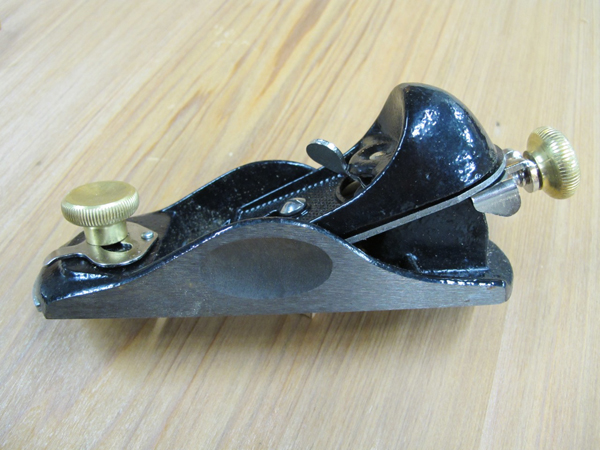Getting Started with 5 Basic Hand Tools
First off, I’m going to focus on what I consider to be the five basic hand tools for working with wood. These are the fundamentals that will allow you to build most anything. Keep in mind that no one tool is right for everyone. The hammer that I love might be the one that makes your wrist sore, or my favorite saw might feel backwards. Don’t be afraid to try different tools and techniques until you find the ones that feel right and make the most sense to you.
The Hammer
Nothing says blunt force like a hunk of metal on the end of a stick. Probably the oldest tool in the book. When I first started woodworking, I remember seeing a picture of a guy with his hammer collection, it was a whole room filled with hundreds of different hammers. At the time, I couldn’t imagine needing more than one, but I feel much differently now. Within eyeshot as I type this, I can see nine hammers. Each is different and each sees (fairly) regular use. The one pictured above is easily my favorite. It’s a 375g Japanese carpenters hammer. One face is flat, for driving nails, the other is slightly convex for driving the nail below the surface. I use it for everything from driving chisels and adjusting planes to knocking joints together and closing cans. It’s my go-to hammer. The weight is right and I like its balance. If your work will require a lot of nailing, a claw hammer might be a better choice. For me, I would probably stick with this one and add a small pry bar to my collection. A tip for the claw hammer users: when doing lighter chopping, try using the side of the hammer head to drive the chisel instead of the face. It gives you more control and a larger striking area.
Chisels
Next in line is the chisel. It can be used for anything from heavy chopping to light paring or fine carving. While also known to open paint cans, turn screws, and act as a pry bar, these are not recommended uses. Seriously, use a screwdriver. A screwdriver will appreciate the attention. While there are hundreds of chisel sizes and styles, most people can get by with four. I would recommend 1/4, 1/2, 3/4, and 1″ standard bench chisels. Select ones that feel good in your hand and learn how to sharpen them. There are virtually no chisels that are ready to use right off the shelf, they all need some sharpening to get them to sing. Once you experience a truly sharp chisel, you will understand the difference, not only by what you’re able to achieve, but the ease with which you can do it. Above is a heavy patterned chisel called atsu-nomi (thick chisel) that’s used for cutting joints in large timbers. It’s part of a set made for me by master blacksmith Iyoroi and it’s one of my favorites.
Hand Planes
Historically, hand planes were used mostly (but not exclusively) for smoothing and adjusting the thickness of rough board (called “thicknessing”). While some still prefer to work this way, when it comes to dimensioning stock, most of the heavy work is done by machines. This doesn’t mean the hand plane is obsolete. It remains an incredibly useful tool that no woodworker should be without. A well-tuned plane can do in minutes what can take a sander an hour, and produce an arguably better surface in the process. It also allows you to work while standing in a pile of shavings instead of a cloud of dust. If I had to choose only one, it would be a low-angle block plane like the one here. Aside from being fairly easy to set up and sharpen, it can be used for everything from trimming and shaping stock to finish planing surfaces. And like chisels, they’re rarely ready to use out of the box. They should be looked at more as a kit that you have to finish before it’s ready to use. (Basic chisel and plane set up and sharpening will be covered in an upcoming post.)
Hand Saw
As with the hand plane, much of the work a saw preforms has been picked up by the powered version. Even so, the handsaw remains a useful and necessary part of a woodworker’s collection. When it comes to saws for cutting wood, there are two basic types: rip saws and crosscut saws. Rip saws are meant to cut in the direction of the grain and typically have fewer, bigger teeth. Crosscut saws are, as the name implies, for cutting across the grain. They typically have more and finer teeth in order to shear the grain and leave a cleaner cut. While combination and general purpose saws exist, they tend to be a little too aggressive for careful work. My choice of hand saw is a Japanese ryoba nokogiri (double blade saw). It has rip teeth on one side, crosscut teeth on the other, and unlike western saws, it cuts on the pull stroke. While they used to be difficult to find, you can now usually get them at home stores.
Clamps
Last on the list is the clamp. Without clamps, nearly every operation with the tools above becomes more difficult. Not only are they good for holding together the final assembly, their ability to keep things where you want them while you work is invaluable. There is little that is more frustrating than trying to work a piece of wood that keeps sliding around. A couple of clamps are essential and most woodworkers, at least once in their life, have repeated the mantra “you can never have enough clamps.” Usually while wishing they had one or two more. Two 24″ bar clamps are good. Four are better. Eight are better still…








